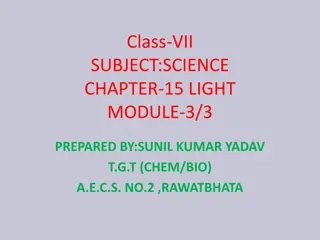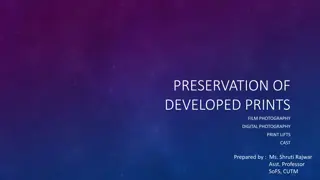Mastering the Basics of Photography: Types of Cameras, Lenses, and Exposure Triangle
Explore the fundamentals of photography including types of cameras (Compact, Bridge, Mirrorless, DSLR), lenses (Wide-angle, Telephoto, Zoom, Prime), and the Exposure Triangle (Shutter speed, Aperture, ISO). Understand the importance of each element in capturing stunning images.
Download Presentation

Please find below an Image/Link to download the presentation.
The content on the website is provided AS IS for your information and personal use only. It may not be sold, licensed, or shared on other websites without obtaining consent from the author.If you encounter any issues during the download, it is possible that the publisher has removed the file from their server.
You are allowed to download the files provided on this website for personal or commercial use, subject to the condition that they are used lawfully. All files are the property of their respective owners.
The content on the website is provided AS IS for your information and personal use only. It may not be sold, licensed, or shared on other websites without obtaining consent from the author.
E N D
Presentation Transcript
What are the basics? Types of camera Compact Bridge Mirrorless DSLR Types of lenses Wide-angle v telephoto Zoom v prime Exposure Triangle Shutter speed/Time value Aperture ISO Focus Focus points Single area/One shot v Continuous/AI Servo autofocus Back button focusing Other settings
Types of camera Compact cameras(or point-and-shoot ) are cheap but don t have good sensors or large zooms Bridge cameras offer great zoom ranges, but the sensor is not large enough to give high quality images Mirrorless camerasare lighter than DSLRs but don t have an optical viewfinder DSLRs are the gold standard and can be either cropped (Nikon s DX or Canon s EF-S) or full-frame
Types of lens (1) Wide-angle lenses have a short focal length (around 9mm for fish-eye lenses all the way up to 35mm) Good for landscapes Emphasise the distance between objects Standard or normal lenses imitate the focal length of the human eye, which is around 50-55mm Good for general use, street photography Lighter, faster and cheaper than telephoto lenses Mid-range lenses plug the gap between standard and telephoto lenses An 85mm lens is the standard portrait lens Long or telephoto lenses have a longer focal length (from 200-800mm) Good for wildlife or sports photography Bring objects closer Flatten perspective
Types of lens (2) Zoom lenses have a variable focal length, eg 18- 35mm Convenient Cheaper than having to buy different lenses Not such high quality as primes Prime lenses have a fixed focal length, eg 800mm Higher optical quality Generally faster , ie offering a wider maximum aperture in low light Less flexibility in composition
The Exposure Triangle (1) The overall brightness of an image is measured in Exposure Values (EV) or stops Each doubling of the light increases the EV by one (and vice versa) You can make your image darker or lighter by changing any of the settings in the Exposure Triangle: Shutter speed/Time value is the length of time that the shutter is open, exposing the sensor (or film) to light, eg 1/1000 of a second Apertureis the focal length divided by the size of the entrance pupil (ie the size of the hole!), eg a 50mm lens with a 10mm hole in it has an f-number of 50 10 = f/5 ISO stands for International Organization for Standardization and measures the sensitivity or speed of the sensor (or film), eg ISO 100 or ISO Auto Cameras think the world is 18% grey, so, if you think the camera is going to be fooled by the light conditions, you can add or subtract one or two stops of exposure compensation , eg +2EV for a polar bear on the ice If light conditions are changeable or you don t trust the camera to get the exposure right, you can use bracketing , which allows you to take multiple shots at different shutter speeds or apertures If there is a high dynamic range (ie both very dark and very light patches), you can turn on Auto D- lighting/Auto Lighting Optimizer to make sure you get visible detail in all areas of the picture
The Exposure Triangle (2) Exposure or shooting modes Auto or Scene means the camera automatically sets both the aperture and the shutter speed given the conditions, eg landscape or wildlife Programmed auto (P) means you can choose different combinations of aperture and shutter speed, eg 1/1000 at f/8 or 1/500 at f/16 Shutter priority (S) means you set the shutter speed, but the camera automatically sets the aperture Aperture priority (A) means you set the aperture, but the camera automatically sets the shutter speed Manual (M) means you set the aperture and the shutter speed yourself
The Exposure Triangle (3) There is only so much light to go round, so choose a good compromise! If the Shutter speed/Time value is too slow, a moving subject will be blurred or you ll get camera shake If the Aperture is too wide, the Depth of Field (DoF) will be too low, and you ll get blur If the ISOis too high, you ll get grain or noise
Focus Cameras are now equipped with sensors that make autofocus fast and effective Focus points can be chosen manually in the viewfinder to tell the camera where to focus Single area/One shot is a one-off, static adjustment best for stationary subjects Continuous/AI Servo constantly updates the focus so is best for tracking moving subjects Back button focusing allows you to keep focusing even while you re taking pictures and/or to lock the focus and recompose Just make sure the focus mode switch on the lens is set to M/A or A/M rather than M, or you ll switch to manual focus!
Other settings Quality means the format of the image, eg RAW or JPEG White balance is the colour of the light, eg daylight or flash Drive mode can be single shot (S) or continuous shooting (C), eg 7 frames per second (fps) Depth of field preview allows you to check what will be in focus by pressing a button to close the aperture to the chosen setting Vibration Reduction/Image Stabilisation must be turned on to help keep the camera steady in order to get sharper pictures Normal is fine for general use Active is only necessary if you are not standing still, eg on a boat Lens lock is just a button to lock a zoom lens to the shortest focal length for convenience when carrying it around Flash and video are available on most cameras but must be turned on manually























